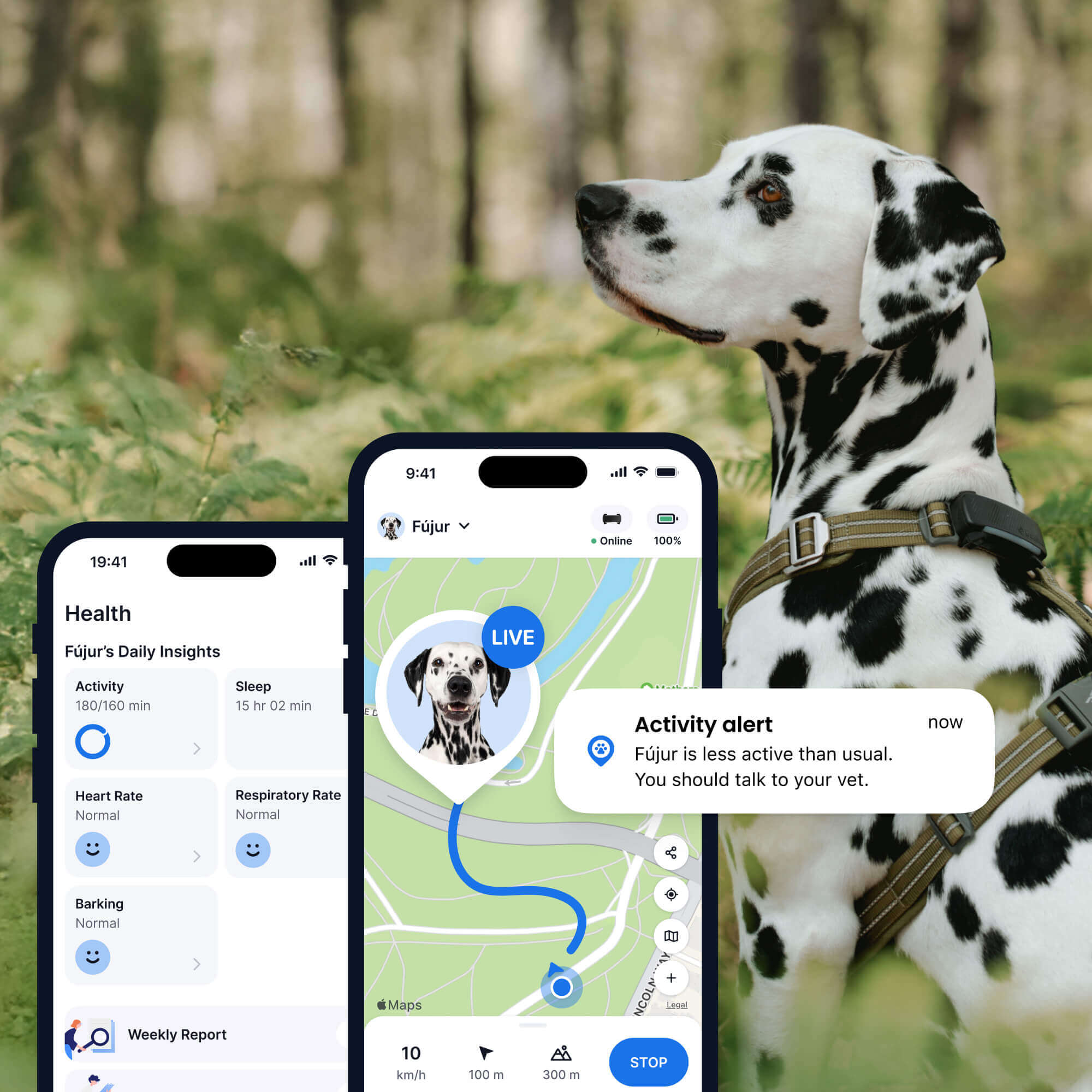 Approved by Dr. Dwight Alleyne, DVM
Approved by Dr. Dwight Alleyne, DVM Old Dog Seizures: Why They Happen & What To Do
It can be scary dealing with seizures, panting, and shaking in old dogs - why do they happen & what do you even do? Here's how to keep your furry friend safe and live their happiest, healthiest life by your side.

Caring for an older buddy can be a blessing and challenge all the same – but let’s admit it: dealing with panting, shaking, or even seizures in old dogs can be pretty scary! So we’ve covered more about what these behaviors mean, how to handle old dog seizures, and how monitoring your dog’s sleep can help you catch on to a health issue early.
Key Takeaways
While some panting and trembling may stem from age-related changes or anxiety, they can also signal pain, heart disease, cognitive decline, or other medical issues in senior dogs.
Head to your vet if symptoms occur frequently, are severe, or come with disorientation, weakness, or behavioral changes.
The Tractive GPS & Health Tracker offers vital signs and activity monitoring, helping you spot early signs of discomfort, unusual rest patterns, or a change in your dog’s breathing and heart rate – so you can take action right away.

Always know your buddy is healthy & safe
Read moreShaking in old dogs
Just like humans, dogs can suffer from seizures too. In fact, seizures are among the most commonly-reported neurological conditions in dogs.1 And since dogs tend to live shorter lives than us humans, they do also age more rapidly than us.
But while it’s common for dogs to develop tremors in their hind or front legs as they get older, shaking can also indicate that the dog is:
- In pain
- Excited
- Nauseous
- …or suffering from a more serious illness
And here’s some reassuring news: only a small percentage of dogs are likely to experience seizures in their lifetime.2
What might cause my dog to shake more than usual?
You might find your senior dog shaking as a result of excitement – or some of these more concerning reasons:
- Old age
- Pain
- Poisoning
- A neurological disorder
- Kidney failure
- Adrenal gland disease
- Anxiety
As in the case with panting, if you suspect that your old dog is shaking too much or abnormally, take a trip to your vet who will be able to complete a full health assessment of your dog.
⚠️ Besides occurring while they’re up and about, your dog might also experience shaking or twitching while asleep. Which, with time, can mess up their sleep cycles – and worsen their health down the line. A Sleep Tracker for dogs can help you pick up on these disturbances quicker and easier, so you can take action early on.

Get health alerts for your dog
Our pups can’t always tell us if something’s wrong. But if their tracker detects unusual changes in their routine, you’ll get an alert, helping you catch potential issues early.
Old dog seizures
Seizures in old dogs are not a typical sign of aging. Only a small percentage of dogs will experience a seizure at some point in their lives. Seizures can occur in dogs of all ages – and both while they’re awake or asleep.
But before we all panic – old dog seizures are still different from them twitching or shaking while asleep. (Which may be due to completely benign reasons, like your dog simply dreaming or reacting to a sound, while still asleep.)
⚠️ However, if you’re noticing them twitching while asleep, it may be a result of a seizure as well.3 So here are some of the key differences between regular sleep – or if your dog is experiencing a seizure:
| Regular sleep | Seizure | |
| Body | Flexible, relaxed | Stiff |
| Breathing | Normal, occasionally irregular | Labored |
| Eyes | Partially or completely closed | Wide open, but not reacting |
| Consciousness | Your dog will respond to your voice and wake up easily | Your dog might lose consciousness and not respond to your voice |
Causes of seizures in dogs
- Environmental causes
For example, if your dog ingests a poisonous toxin - Illness
Such as brain tumors, epilepsy, brain trauma, liver disease, kidney failure, diabetes, or Cushing’s disease - Genetic predisposition
Certain breeds are more likely to experience a seizure than others.
Which dog breeds are prone to seizures?
The condition of idiopathic (or primary) epilepsy, for example, is a major cause of seizures in dogs. It is most often inherited in these dog breeds:
- Australian Shepherds
- Belgian Tervuren
- Beagles
- Bernese Mountain Dogs
- Border Collies, Border Terriers
- Cavalier King Charles Spaniels
- Dachshunds
- English Springer Spaniels
- Finnish Spitz
- German Shepherds
- Golden Retrievers and Labradors
- Irish Wolfhounds
- Keeshond
- Lagotto Romagnolos
- Petit Basset Griffon Vendeens
- Shetland Sheepdogs
- Standard Poodles
- Vizslas³.
⚠️ Watch out though: epilepsy – as well as non-epileptic seizures – can occur in dogs of any breed or age! So even if your dog falls into one of the breed categories above, it does not necessarily mean that he or she will suffer from a seizure at some point in life. Other factors may also play a role – like, for example, your dog’s sex. (With male dogs being more susceptible to seizures than female dogs5.)
Most importantly, you should learn how to recognize when your dog is having a seizure, so that if this condition affects your dog someday, you’ll be prepared to take the appropriate action to ensure his safety.
Symptoms of seizures in old dogs
If your dog experiences a seizure while awake, it may typically include:
- Collapsing – often falling to the side
- Jerking or stiffening
- Muscle twitching
- Loss of consciousness
- Chewing the tongue or chomping
- Drooling or foaming at the mouth
- Urinating or defecating
Witnessing your buddy have a seizure can be heart-wrenching – and it’s understandable if you feel helpless or unsure what to do. So here are some steps you can take to handle it.
What to do if your dog has a seizure
If your dog is experiencing a seizure, here’s what you should do to ensure the best outcome:
- Stay calm.
- Remove any objects nearby which could potentially hurt your dog.
- Keep away from the dog’s head and mouth and do not put anything in their mouth.
- Time the seizure if possible.
- Cool your dog down by putting a fan on them or cold water on their paws.
- Talk softly to your dog to help him calm down. Avoid touching them.
- Take your dog to the vet immediately once the seizure has ended.
When it comes to old dog seizures, an early diagnosis is always best. Do not let the condition go untreated – at the first sign of a seizure, contact your vet. Your vet will perform a physical exam of the dog, and if possible, prescribe medicine to prevent and control the seizures.
Where Sleep Tracking helps you catch on to a seizure early
Now if you’ve followed these steps, you can successfully intervene if your buddy has a seizure while awake. But how about when they’re sleep? (And especially since you need to get their own sleep?)
💡With a GPS & Health Tracker for dogs, you can monitor how well your buddy’s sleeping, any change in their sleep cycles, and even their vital signs – like their breathing and heart rate. So you can take action and get them to a vet before their health takes a turn for the worse.
Your furry friend’s health and wellbeing means as much as to us as it does to you. So we’ve made it a priority to only share medically-relevant content on our blog. This post was checked, double-checked, and medically verified by Georgia-based vet, Dr. Dwight Alleyne.

Dr. Dwight Alleyne, DVM
Originally from Long Island, New York, Dr. Alleyne began his career at a no-kill animal shelter before becoming a licensed veterinary technician. He graduated from Cornell University Veterinary College in 2006 and completed an internship at Purdue University. Now practicing in Georgia, Dr. Alleyne specializes in soft tissue surgery and ultrasounds. He also writes pet health articles on his website, “The Animal Doctor Blog” (www.anmldrblog.com).




